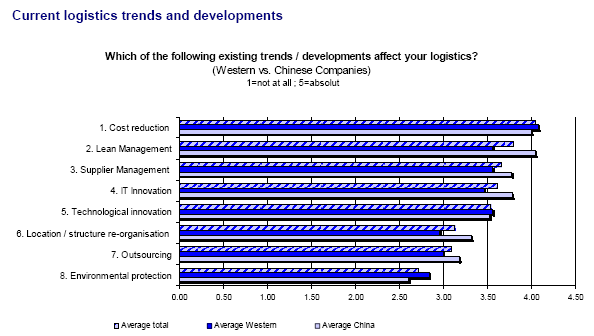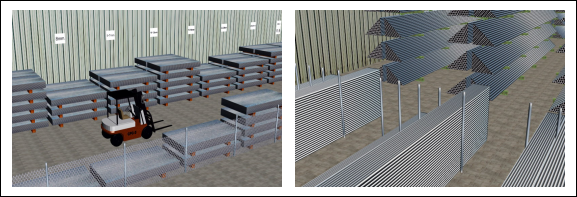




With the current economic situation companies and their logistics orientation faces quiet new challenges. Whereas till recently projects with the goal of expansion and capacity extension were being handled these goals nowadays have been changed drastically. Shrinking sales figures – here especially for export oriented companies – with in the same time decreasing prices lead to huge pressure for competitiveness. Therefore the identification and elimination of cost triggers and the re-organization of production and logistics processes towards lean and efficient systems is nowadays leading the agendas.
Cost consciousness is becoming more and more important today and with that optimization projects such as inventory reduction with the target of improving cash flow and liquidity. Also process optimizations which will lead to improved performance (e.g. fewer resources at same output) are very common at the moment. Those are just two examples where results can be achieved in short term.
As shown in a recent survey of fablog logistics consulting, companies are aware of the fact that taking countermeasures at the moment is highly necessary. It was clearly stated that cost optimization and lean management (which are directly connected to each others) represents the most targeted measurements at the moment.

Illustration 1: „Current logistics trends and developments“; fablog survey „Market developments in China“
It is absolutely essential to act in order to retain or even increase competitiveness. As furthermore stated in the current fablog market trend survey the current crisis also represents an opportunity for companies. It is not only about keeping competitiveness and wait until demand is growing again. It is also about using the existing situation in order to strengthen the own market position. That is also proven by the fact that topics such as technological innovation (e.g. systems and IT) and with that necessary investments can not be found at the very end of current trends.
Companies that are thinking anti-cyclic at the moment and have the necessary liquidity based on sustainable operations in the past are now able to invest. The economy will recover sooner or later. Especially in China the chances are quiet good since the domestic consumption represents still quiet a big potential for further growth.
Why should companies not take the chance to re-organize and modernize existing structures that have been strongly grown over the past decade due to e.g. merger and acquisitions? Right now companies often have free resources to modify systems, networks and structures towards changed market demands and customer requirements such as:
Re-organization of rigid and inflexible systems
Elimination of single solutions and definition of standards within the entire organization (IT, Documentation, Processes)
Modernization of logistics concepts and strategies (storing, production supply , C-parts management)
Implementation of state of the art systems and equipment
New orientation of networks (transport, distribution)
Companies which consider that opportunity might leave the economic downturn stronger than before. That was also recognized by an traditional local manufacturer from the heavy machine industry. That company was tremendously growing over the past years without adopting their logistics. They have assigned fablog with the modernization of the entire production logistics:
In a common first work shop the framework, the restrictions and especially today’s situation as well as the expected future development was being defined accurately. Moreover a focus of these workshops were the very individually developed process landscape on the one hand as well as the plausibility checks of the given inventory and production data including parts lists, production plans, ranges of coverage, order times, etc. on the other hand. Target was to define a very clear and accurate data base in order to identify and fully utilize all existing potentials within inventory, operation and the organization with a focus on documentation and information flow.
Based on the results of that data analysis the concept phase will follow. Here different solutions have been developed. It was aimed to develop these different technical and organizational approaches in order to finally compare and evaluate them with support of modern simulation software. Each of the planning results of the solutions was undergoing several different scenarios (e.g. emergency due to broken stacker) that might occur during operation. Here different comparison stages were developed. At first – for regular parts stored on standard pallets - a manual concept was compared with an automatic solution. Moreover within the “best practice concept” – the automatic solution – different material handling technology was evaluated. Besides the regular handing over of pallets via fork lifts to the ASRS an automatic pallet conveyor as well as a vertical shuttle conveyor was compared. Considering factors such as throughput capacities, distances and handling time, process security, failure rates, etc. the most efficient solution was identified.

Illustration 2: „ASRS - Automatic pallet rack system“; fablog consulting
Due to a huge variety of SKU’s as well as many oversized and heavy parts one focus in planning the logistics was an intelligent storing strategy. Based on SKU’ characteristics such as weight and dimension, inventory amount, picking frequency and picking volume different storing areas were set up. Regarding those factors a small parts storing area, an automatic pallet rack for full pallets as well as a manual pick pallet rack were defined. Furthermore special storing areas were part of that logistics concept. A cantilever rack for long goods and a block storing area for heavy and oversized parts was planned. With a clear separation of these storing areas the handling and organization could be clearly enhanced.

Illustration 3: „Storing solution for heavy and oversized parts / block storage and cantilever rack“; fablog consulting
Besides the raw material storing area a temporary buffer area had to be integrated. Semi finished parts which are being processed but not immediately required for further manufacturing had to be stored efficiently without wasting to much space and demanding to many resources. Therefore with the help of simulation the most efficient location was calculated. Target was to have short distances, no crossing traffics with other major transport ways as well as quick and easy handling in order to reduce these times and the belonging resources.
The technical design of the storing areas was one part of the concept. But also the material handling plays an important role. Different materials require different handling equipment such as fork lifts, cranes or conveyors for the in order to efficiently supply the production line. One important part of the logistics layout was the definition of the required buffer space in the actual production area. Based on a clear material supply process as well as the definition of standard storing units at the production line the required buffer areas per machine could be defined.
Directly connected to the material flow is the information flow. Here the data transfer via implementation of WMS and a modern barcode / scanner system was improved and each single process was designed.
That holistic approach within the re-organization and modernization of the logistics and production was responsible for overall improvement resulting into a better performance including a cost efficient handling, lean organization and reduced failures which again will increase customer satisfaction. With that re-organization project that company is now well prepared and ready to face further competition. They have recognized technical innovation and modernization as one key to success.

Illustration 4: „Summary of countermeasures and results”; fablog consulting